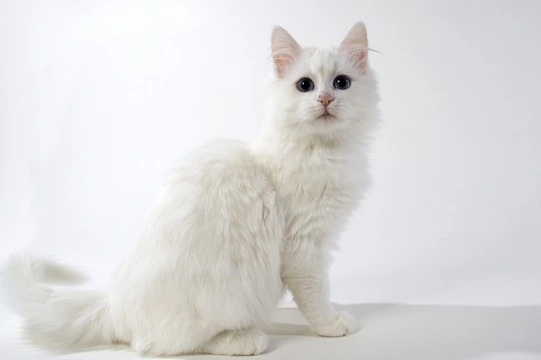
The Turkish Angora cat- a beautiful longhaired companion
The Turkish Angora is one of the most ancient breeds of naturally occurring domestic cats, and gets its name from its geographical origins. The Turkish Angora hails of course from Turkey, in the region that is now known as Ankara but was traditionally known as Angora.
Interestingly, the Turkish Angora (or just “Angora” for short) is believed to be the cat breed that is responsible for introducing the gene for white fur into the wider cat population, and also the gene for long hair! This means that all longhaired or white cats that we know today, including hugely popular and high profile breeds like the Persian cat, probably owe some part of their genetic makeup to the Angora.
The Turkish Angora history and the Persian connection
The known history of the Turkish Angora cat stretches back for hundreds of years, with documentation showing that the Angora was already well established and popular in its home country by the 1600’s.
The Turkish Angora has a long history of association with the Persian cat, and it is thought that Persian cat was in fact developed from the Turkish Angora rather than being a naturally occurring and totally unrelated cat breed! During the 1900’s, the terms “Persian” and “Turkish Angora” were used interchangeably, and the cats were in fact exactly the same thing!
The Angora cat continued to be bred into Persian breed lines throughout the early half of the 20th century, in order to improve the quality of the Persian coat. However, around the middle of the century when the traditional appearance of the Persian cat changed into the squashed up facial shape that we know today, the Persian breed and the Turkish Angora became clearly distinct from each other and much further removed.
Turkish Angora cats with a pure white coat are considered to be a National Treasure in their native country, and Ankara Zoo (located within the breed’s home region) began a controlled breeding programme in the early part of the 20th century to preserve the white coated variant of the breed and produce high quality descendents of the breed in perpetuity.
The appearance of the Turkish Angora
The Turkish Angora is a medium sized cat with a long, silky plumed tail and proportionate body. They have a medium to long length single-layered coat, and often present a distinctive profile when walking by carrying their tails pointed straight up!
While most people think of the Turkish Angora as being white cat with different coloured eyes (one blue and one green or amber), this is not always the case. The Turkish Angora can present in many different colour variants, including black, tabby and blue. Also, not all Turkish Angoras have odd eyes, and their eyes may be blue, amber or green (or as mentioned, different colours to each other)!
Due to the white coat and propensity to blue eyes, cats with these traits may also inherit the gene for deafness.
Turkish Angora personality
The Turkish Angora very much enjoys human company and bonds strongly with their families, often particularly preferring the company of one member of the household. They are busy, active cats that like to be able to go outside, and are often skilled hunters! The Turkish Angora is considered to be one of the most intelligent breeds of cat, and enjoys puzzle games and other mental exercises that will hold their attention!
They also enjoy climbing, both trees and household objects, and will usually enjoy having a bed high up where they can keep an eye on what is going on around them!
Turkish Angora health
The white coat and blue eyes or odd coloured eyes that commonly appear within the Turkish Angora is associated with hereditary deafness, and cats with a white coat and one blue eye will sometimes be deaf in the ear on the same side as the blue eye. In cats with two blue eyes, the cat runs the risk of being deaf in both ears. However, odd eyes or blue eyes do not automatically indicate deafness, and many cats with eyes like this and the accompanying white coat will have normal hearing.
While the Turkish Angora is considered to be one of the most healthy and robust pedigree cat breeds, they do have a very slightly heightened propensity to two particular inheritable conditions:
They have slightly elevated risk factors for a heart condition called hypertrophic cardiomyopthy, which is also found in the Persian cat and various other pedigree breeds. The condition is more common in males than females, and usually presents itself for the first time after the cat has reached two years old. The condition is hereditary, and results from a gene mutation.
Hereditary ataxia, which causes a range of physical problems such as uncontrolled head shaking in affected kittens is another hereditary risk for the Turkish Angora, and kittens that inherit the condition usually die before reaching maturity.
The average lifespan of the Turkish Angora cat commonly reaches over 15 years old, and even sometimes as old as 20. This robust and ancient breed is one of the healthiest pedigree cat types around, making it a true friend for life!
Please visit our Turkish Angoras page for cats for sale from breeders.



